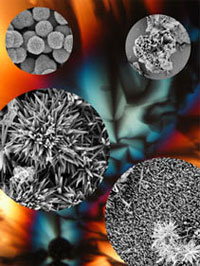Modern, efficient, rechargeable batteries and fuel cells require materials with an enhanced ability to conduct lithium ions. German researchers have now developed a new class of inorganic ionic conductor with a structure analogous to that of the mineral argyrodite. A team led by Hans-Jörg Deiseroth in Siegen, Germany reports, in the journal Angewandte Chemie, the characterization of the most conductive representative of the man-made argyrodite minerals made of lithium, phosphorus, sulfur, and bromine atoms.
In ionic conductors, charge is not transported in the form of electrons as it is in metals; instead, the charge is transported in the form of charged particles—typically, lithium ions. This transport requires materials in which the lithium ions can move as freely as possible. The team from the University of Siegen, in cooperation with scientists at the University of Münster, started from a long-known mineral: argyrodite is a silver-, germanium-, and sulfur-containing mineral discovered near Freiberg, Germany in 1885 and the silver ions in this material are very mobile.
The individual components of argyrodite can be replaced by a number of other atoms without altering the typical structure of the mineral. The term argyrodite now refers to an entire class of compounds that have a specific arrangement of atoms and type of structure. The team led by Deiseroth produced a version of the mineral in which silver is replaced by lithium, germanium by phosphorus, and some of the sulfur atoms by halides (chloride, bromide, or iodide), resulting in argyrodite-like structures that have a composition of Li6PS5X (X: Cl-, Br-, or I-)
In the crystal lattice the phosphorus, sulfur, and halide atoms adopt a dense tetrahedral packing arrangment in which the gaps are filled somewhat regularly with lithium ions. The lithium ions can “jump” from gap to gap. The freely moving ions indicate that the solid has a high ionic conductivity and the reported bromine-containing structure has the highest ionic conductivity of lithium ions known for any argyrodite to date.
The scientists have thoroughly examined the lithium argyrodites by single-crystal X-ray crystallography and nuclear magnetic resonance spectroscopy. This analysis allowed precise characterization of the crystal structures of these compounds and provided fascinating insights into the dynamics of the mobile lithium ions.


